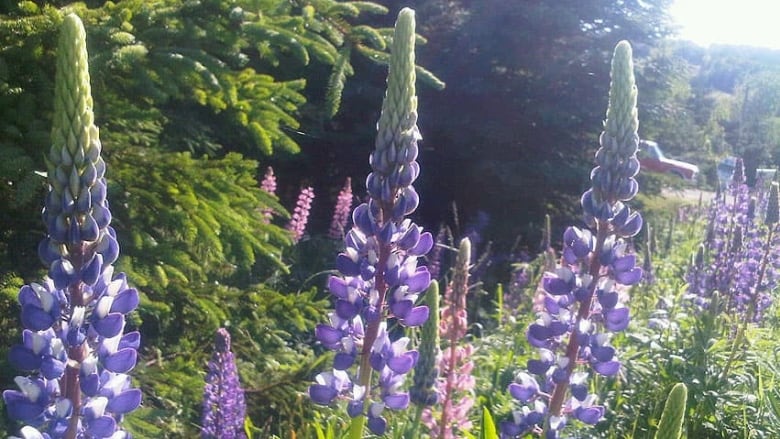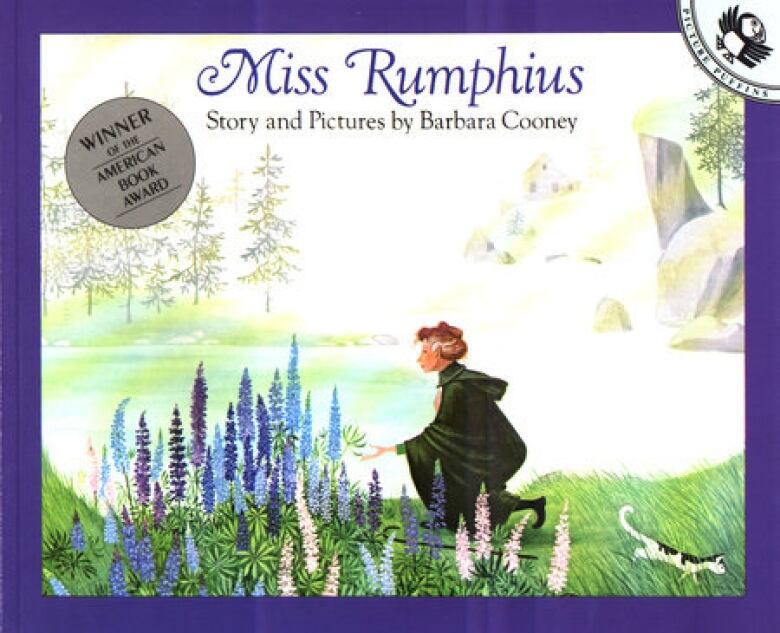Mixed blessings: the pros and cons of lovely lupins
New Brunswick Invasive Species Council says the plant is not always a welcome sight

In the children's picture book, Miss Rumphius by Barbara Cooney, Alice is a young woman who travels the world. When she gets older, she lives in a cottage by the sea and spends her days scattering lupin seeds to make the world a more beautiful place.
The cover of this award-winning story shows Alice, Miss Rumphius, kneeling before a patch of lupins in the woods.
As depicted in that childhood classic, lupins also grow wild in many places, including here in New Brunswick. They pop up in fields and ditches, and they're also planted by people looking to bring the beauty of those purples and pinks to their own yards.

But along with the beauty comes a host of other issues, not all of them beneficial.
Lupins are considered to be an invasive species, according to Kristin Elton, program director at the New Brunswick Invasive Species Council.
'Everyone sees it as a very iconic kind of East Coast species," Elton said, speaking to Shift New Brunswick, but the plant is actually native to the west coast of North America.
"And the reason that it poses the problem is that it can get into areas and it just takes over. So it's one of these invasive plants that reproduces really quickly."
That's a problem, Elton said, because lupins use up resources from other plants. On the other hand, they're what she calls a nitrogen-fixing plant, which means they take nitrogen from the atmosphere and end up putting that nitrogen into the soil.

"We need nitrogen. It's one of the building blocks of life. And it can help improve soil quality, actually. So that is a benefit. It can also be used to help control erosion in some places, Elton said.
Another mark on the pro side for lupins? Bees love them.
But on the con side?
"There's research that shows that we see decreased plant biodiversity and decreased butterfly species in areas that have been invaded by lupins."
And these are hardy plants, which is why you see them clustered in ditches and along the roadside. They don't need good, nourishing soil to proliferate.
For backyard gardeners longing for their wild appeal,lupins can be grown from seeds. George Scott, of Scott's Nursery in Fredericton, saidlupins are always popular with gardeners, but surprisingly, some have told him they've had trouble getting the plants to grow.

"If they have reasonable light, you know, they like a sunny area, and with reasonable light and soil you would start them from seedfairly easily. Or you could, you know, put in atransplant."
"We do sell a lot of different colours," Scott said.Along with the deep blues andpurples, "you'll get the yellows and bi-colours."
Scott also points out, as Elton does, the plants do have some benefits, along with providing beauty to the beholder.
"They're using them sometimes to reclaim ground, like where they were perhaps lifting sod or something like that."
Elton saidthere is a native species of lupin called thesundial lupin, or, just to make things complicated, sometimes known as the wild lupin, even though they're much less common in the wild.
"So if people can get their hands on those, that would be a fantastic alternative. And then that way, you know, that you're planting something that, you know, will benefit all the, you know, the pollinators in the region because it evolved in that place," she said.
"But unfortunately, the ones that people see along the sides of our road right now in bloom are not the ones that we would prefer to have here."
Lupins may be on the invasive list, but Elton said don't worry. The invasive species council is not going to ask you to uproot them.

"There is such a connection to lupins in the region," she said.
"I don't think it would go over well if we told everybody to get rid of their lupins," she said. The council just wants people to be aware of some of the drawbacks that go hand-in-hand with their beauty.
Miss Rumphius would approve.
With files from Shift












_(720p).jpg)


 OFFICIAL HD MUSIC VIDEO.jpg)
.jpg)



























































































